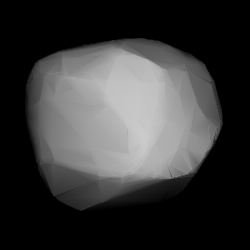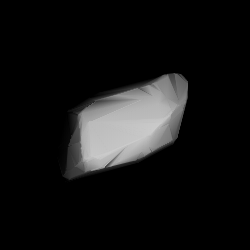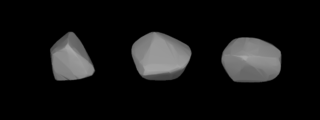
Lumen is a carbonaceous asteroid from the intermediate asteroid belt, approximately 130 kilometers in diameter. It is an identified Eunomian interloper.

Ariadne is a fairly large and bright main-belt asteroid. It is the second-largest member of the Flora asteroid family. It was discovered by N. R. Pogson on 15 April 1857 and named after the Greek heroine Ariadne.

Hekate is a large main-belt asteroid.

Aemilia is a large main-belt asteroid. Aemilia was discovered by the French brothers Paul Henry and Prosper Henry on January 26, 1876. The credit for this discovery was given to Paul. It is probably named after the Via Aemilia, a Roman road in Italy that runs from Piacenza to Rimini.

Arete is an asteroid in the asteroid belt. It has a very bright surface, even so when compared to other rocky S-type asteroid.

Sita is a background asteroid from the inner region of the asteroid belt, approximately 11 kilometers in diameter. It was discovered on 14 October 1884, by an Austrian astronomer Johann Palisa in the Vienna Observatory. It was named for the Hindu deity Sita.

Eukrate is a rather large main-belt asteroid. It is dark and probably a primitive carbonaceous body. The asteroid was discovered by Robert Luther on March 14, 1885, in Düsseldorf. It was named after Eucrate, a Nereid in Greek mythology.

Tyche is a relatively large main belt asteroid discovered by Robert Luther at Düsseldorf-Bilk Observatory on 4 May 1886. The stony S-type asteroid measures about 65 kilometers in diameter and has a perihelion of 2.1 AU.

Lucretia is an asteroid belonging to the Flora family in the Main Belt. It was discovered by Austrian astronomer Johann Palisa on 31 October 1888 in Vienna, and is named after the middle name of Caroline Herschel, one of the first female astronomers. Light curves of this asteroid show a synodic rotation period of 4.349±0.001 h with an amplitude of 0.3–0.4 magnitude. The spin axis appears nearly perpendicular to the ecliptic.

Alice is a stony background asteroid from the inner region of the asteroid belt. It was discovered by Johann Palisa on 25 April 1890 at the Vienna Observatory.

Ludovica is a main belt asteroid.

California is an asteroid belonging to the Flora family in the Main Belt. It was discovered by Max Wolf on 25 September 1892 in Heidelberg, and is named for the U.S. state of California. This object is orbiting the Sun at a distance of 2.20 AU with a period of 3.26 yr and an eccentricity (ovalness) of 0.19. The orbital plane is inclined at an angle of 5.7° to the plane of the ecliptic.
Berolina is a typical Main belt asteroid.
Gryphia is an S-type asteroid belonging to the Flora family in the Main Belt. Its diameter is about 15 km and it has an albedo of 0.168.
Friederike is a minor planet orbiting in the asteroid belt. It is a member of the Hygiea family of asteroids.

Jetta is a minor planet orbiting the Sun. It is estimated to be 24 km in diameter.
630 Euphemia is a mid-sized Eunomian asteroid.
657 Gunlöd is a dark background asteroid orbiting in the intermediate asteroid belt, approximately 43 kilometres (27 mi) in diameter. It was discovered on 23 January 1908, by astronomer August Kopff at the Heidelberg Observatory in southwest Germany. It has an albedo of around 0.042 and a rotation period of 15.7 hours.

685 Hermia is an S-type asteroid belonging to the Flora family in the Main Belt. Its diameter is about 11 km and it has an albedo of 0.281.

6312 Robheinlein (prov. designation:1990 RH4) is a bright Augusta or background asteroid from the inner regions of the asteroid belt, that measures approximately 3.5 kilometers (2.2 miles) in diameter. It was discovered on 14 September 1990, by American astronomer Henry Holt at the Palomar Observatory in California. The uncommon L-type asteroid was named for American science fiction writer Robert A. Heinlein.















